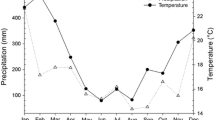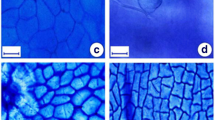Abstract
Knowledge of the leaf anatomy of grassland plants is crucial for understanding how these plants adapt to the environment. Tibetan alpine grasslands and Inner Mongolian temperate grasslands are two major grassland types in northern China. Tibetan alpine grasslands occur in high-altitude regions where the low temperatures limit plant growth. Inner Mongolian temperate grasslands are found in arid regions where moisture is the limiting factor. Few comparative studies concerning the leaf anatomy of grassland plants of the Tibetan Plateau and Inner Mongolian Plateau have been conducted. We examined leaf characteristics at 71 sites and among 65 species, across the alpine grasslands of the Tibetan Plateau and the temperate grasslands of the Inner Mongolian Plateau. We compared the leaf structures of plants with different life forms and taxonomies, and their adaptation to arid or cold environments. We explored relationships among leaf features and the effects of climatic factors (i.e., growing season temperature and precipitation) on leaf characteristics. Our results showed that (i) there were significant differences in leaf anatomy between Tibetan alpine and Inner Mongolian temperate grasslands. Except for mesophyll cell density, the values obtained for thickness of leaf tissue, surface area and volume of mesophyll cells were larger on the Tibetan Plateau than on the Inner Mongolian Plateau. (ii) Within the same family or genus, leaf anatomy showed significant differences between two regions, and trends were consistent with those of whole species. (iii) Leaf anatomy of woody and herbaceous plants also showed significant differences between the regions. Except for mesophyll cell density, the values obtained for the thickness of leaf tissue, and the surface area and volume of mesophyll cells were larger in herbaceous than in woody plants. (iv) Leaf anatomical traits changed accordingly. Total leaf thickness, thicknesses of lower and upper epidermal cells, and surface area and volume of mesophyll cells were positively correlated, while mesophyll cell density was negatively associated with those traits. (v) Growing season temperature had stronger effects on leaf anatomy than growing season precipitation. Although the communities in Tibetan and Inner Mongolian grasslands were similar in appearance, leaf anatomy differed; this was probably due to the combined effects of evolutionary adaptation of plants to environment and environmental stress induced by climatic factors.
Article PDF
Similar content being viewed by others
Avoid common mistakes on your manuscript.
References
Breckle S W. Walter’s Vegetation of the Earth. 4th ed. New York: Springer-Verlag, 2002
Piao S L, Fang J Y, He J S, et al. Spatial distribution of grassland biomass in China. Acta Phytoecol Sin, 2004, 28: 491–498
Chen Z Z, Wang S P. China Typical Grassland Ecosystem. Beijing: Science Press, 2000
Ma W H, He J S, Yang Y H, et al. Environmental factors covary with plant diversity-productivity relationships among Chinese grassland sites. Global Ecol Biogeogr, 2010, 19: 233–243
Li W H, Zhou X M. Ecosystems of Qinghai-Xizang (Tibetan) Plateau and Approaches for Their Sustainable Management. Guangzhou: Guangdong Science and Technology Press, 1998
Fei S L, Fang J Y, Fan Y J, et al. Anatomical characteristics of leaves and woods of Fagus lucida and their relationship to ecological factors in Mountain Fanjingshan, Guizhou, China. J Integr Plant Biol, 1999, 41: 1002–1009
Zhang Y C, Zhang J N. Primary study on anatomical structure of leaves of Scorzonera mongolia Maxim. in saline environment. J Ningxia Agricult College, 2001, 22: 38–39
Zhang H X, Liu G H, Cui X P. Affection of aridity to anatomical structure of leave of Ulmus pumila L. var. sabulosa. Bull Bot Res, 2005, 25: 39–44
Rocas G, Scarano F R, Barros C F. Leaf anatomical variation in Alchornea triplinervia (Spreng) Mull. Arg. (Euphorbiaceae) under distinct light and soil water regimes. Bot J Linnean Soc, 2001, 136: 231–238
Chartzoulakis K, Patakas A, Kofidis G, et al. Water stress affects leaf anatomy, gas exchange, water relations and growth of two avocado cultivars. Sci Horticult, 2002, 95: 39–50
Mendes M M, Gazarini L C, Rodrigues M L. Acclimation of Myrtus communis to contrasting Mediterranean light environments-effects on structure and chemical composition of foliage and plant water relations. Environ Exp Bot, 2001, 45: 165–178
Cai Y L, Song Y C. Adaptive ecology of lianas in Tiantong evergreen broad-leaved forest, Zhejiang, China I. leaf anatomical characters. Acta Phytoecol Sin, 2001, 25: 90–98
Rocas G, Barros C F, Scarano F R. Leaf anatomy plasticity of Alchornea triplinervia (Euphorbiaceae) under distinct light regimes in a Brazilian montane Atlantic rain forest. Trees Struct Funct, 1997, 11: 469–473
Shi H Y, Wang Y F, Gao H Y. Adaptation of anatomical structures of the leaves of Saussurea stella Maxim to the alpine environment. Guihaia, 2010, 30: 621–625
Wang H Q, Xu Z, Qi J. Prospect and progress of leaf blade comparative anatomy of Poaceae in China. Grassland Turf, 2009, 133: 93–97
He D M, Liu Q, Lin B, et al. Adaptation of leaf anatomical characteristics of eleven understory species to different environments in Coniferous plantations. Acta Ecol Sin, 2008, 28: 4739–4749
Cui X P, Liu G H, Zhan R L. Comparison of leaf anatomical structure between Salix gordejevii growing under contrasting habitats of Otingdag Sandland and Salix microtachya var. bordensis growing on the lowlands of dunes. Acta Ecol Sinica, 2006, 26: 1842–1847
Lake J A, Quick W P, Beerling D J, et al. Plant development-signals from mature to new leaves. Nature, 2001, 411: 154–154
Pyankov V I, Kondratchuk A V, Shipley B. Leaf structure and spe cific leaf mass: the alpine desert plants of the Eastern Pamirs, Tadjikistan. New Phytol, 1999, 143: 131–142
Rury P M, Dickison W C. Structural Correlations among Wood, Leaves and Plant Habit. New York: Academic Press, 1984
Xie C Z. Difference and relationship between monocotyledonous plants and dicotyledonous plants. Plants, 1983, 3: 24–25
Li F L, Bao W K. Responses of the morphological and anatomical structure of the plant leaf to environmental change. Chin Bull Bot, 2005, 22: 118–127
The Integrated Investigation Team in Inner Mongolia and Ningxia, CAS. Vegetation of Inner Mongolia. Beijing: Science Press, 1985
Yang Y H, Piao S L. Variations in grassland vegetation cover in relation to climatic factors on the Tibetan Plateau. J Plant Ecol, 2006, 30: 1–8
Hijmans R J, Cameron S E, Parra J L, et al. Very high resolution interpolated climate surfaces for global land areas. Int J Climatol, 2005, 25: 1965–1978
He J S, Wang X P, Flynn D F B, et al. Taxonomic, phylogenetic and environmental trade-offs between leaf productivity and persistence. Ecology, 2009, 90: 2779–2791
He J S, Fang J Y, Wang Z H, et al. Stoichiometry and large-scale patterns of leaf carbon and nitrogen in the grassland biomes of China. Oecologia, 2006, 149: 115–122
Gao J P, Wang Y H, Chen D F. Anatomical characteristics of leaf epidermis and vessel elements of Schisandra sphenanthera from different districts and their relationships to environmental factors. Acta Bot Boreali-occident Sin, 2003, 23: 715–723
Li H Q, Ma W Y. The main indexes and analysis methods of drought resistant comparison on sand plants. Arid Zone Res, 1998, 15: 12–15
Kofidis G, Bosabalidis A M, Moustakas M. Contemporary seasonal and altitudinal variations of leaf structural features in Oregano (Origanum vulgare L.). Ann Bot, 2003, 92: 635–645
Li C Y, Zhang X J, Liu X L, et al. Leaf morphological and physiological responses of Quercus aquifolioides along an altitudinal gradient. Silva Fenn, 2006, 40: 5–13
Sam O, Jerez E, Dell’Amico J, et al. Water stress induced changes in anatomy of tomato leaf epidermes. Biol Plantar, 2000, 43: 275–277
Bosabalidis A M, Kofidis G. Comparative effects of drought stress on leaf anatomy of two olive cultivars. Plant Sci, 2002, 163: 375–379
Li C, Cheng M, Tang Y D, et al. Characteristics comparison of leaf anatomy structure and photosynthesis of two Salix species at Qinghai-Xizang Plateau. Acta Bot Boreali-occident Sin, 2009, 29: 275–282
Shi H Y, Wang Y F, Wang J H. Studies on the anatomical structures of leaves of seven Saussurea DC. species on the Qinghai-Tibetan Plateau with different altitude. Bulletin of Botanical Research, 2009, 29: 289–294
Dong J F, Li C H, Liu H G, et al. Analysis of drought resistance by leaf anatomical structure of six species of sandy willows. J Desert Res, 2009, 29: 480–484
Abrams M D, Kubiske M E, Mostoller S A. Relating wet and dry year ecophysiology to leaf structure in contrasting temperate tree species. Ecology, 1994, 75: 123–133
Körner C. Alpine Plant Life. Functional Plant Ecology of High Mountain Ecosystems. Berlin: Springer, 1999
Shi S B, Zhu W Y, Li H M, et al. Photosynthesis of Saussurea superba and Gentiana straminea is not reduced after long-term enhancement of UV-B radiation. Environ Exp Bot, 2004, 51: 75–83
He J S, Chen W L, Wang X L. Morphological and anatomical features of Quercus section and its adaption to the ecological environment. Acta Phytoecol Sin, 1994, 18: 219–227
Yan L, Li H, Liu Y. The anatomical ecology studies on the leaf of 13 species in Caragana genus. J Arid Land Resour Environ, 2002, 16: 100–106
da Costa R C, de Araujo F S, Lima-Verde L W. Flora and life-form spectrum in an area of deciduous thorn woodland (Caatinga) in northeastern, Brazil. J Arid Environ, 2007, 68: 237–247
Li Y L, Mao W, Zhao X Y, et al. Leaf nitrogen and phosphorus stoichiometry in typical desert and desertified regions, North China. Environ Sci, 2010, 31: 1716–1725
Ding T, Du F, Wang J, et al. Analysis on life form characteristics of the mid-montane humid evergreen broad-leaved forest in Lancangjiang Nature Reserve. J Southwest Forestry College, 2006, 26: 19–23
Lin Y M, Wu C Z, Hong W, et al. Analysis on characteristics of plant life-form and leaf in rare and endangered plant Tsuga longibracteata community. J Plant Resour Environ, 2004, 13: 35–38
Huang J J, Wang X H. Leaf nutrient and structural characteristics of 32 evergreen broad-leaved species.32 evergreen broad-leaved species. J Eastchina Normal Univ (Nat Sci), 2003, 14: 92–97
Liu M Z, Jiang G M, Li Y K, et al. Hydrological characteristics of different species in three habitats of Hunshandak Sandland. Acta Ecol Sin, 2004, 24: 1465–1471
Wright I J, Reich P B, Westoby M, et al. The worldwide leaf economics spectrum. Nature, 2004, 428: 821–827
Author information
Authors and Affiliations
Corresponding author
Additional information
This article is published with open access at Springerlink.com
Rights and permissions
Open Access This article is distributed under the terms of the Creative Commons Attribution 2.0 International License (https://creativecommons.org/licenses/by/2.0), which permits unrestricted use, distribution, and reproduction in any medium, provided the original work is properly cited.
About this article
Cite this article
Ma, J., Ji, C., Han, M. et al. Comparative analyses of leaf anatomy of dicotyledonous species in Tibetan and Inner Mongolian grasslands. Sci. China Life Sci. 55, 68–79 (2012). https://doi.org/10.1007/s11427-012-4268-0
Received:
Accepted:
Published:
Issue Date:
DOI: https://doi.org/10.1007/s11427-012-4268-0




